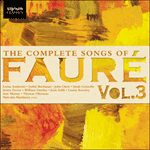‘There are songs of a fragrance, ambiguity and vision unique to Fauré and all the singers involved in this glorious project, while not always in their first radiance and purity of voice, never lose their sense of poetic engagement and commitment. Graham Johnson, whether writing or playing, is magically attuned to every nuance of Fauré's universe; and Hyperion's sound and presentation are impeccable’ (Gramophone)
‘This completes Hyperion's recording of all Fauré's songs master-minded by Graham Johnson with a quintet of specialist singers: Jennifer Smith, Felicity Lott, Geraldine McGreevy, Jean-Paul Fouchécourt and Stephen Varcoe, all in top form here … suffice it to say that this superb enterprise is a jewel in Hyperion's crown’ (The Sunday Telegraph)
‘The sound is warm and initimate and Johnson's comprehensive notes are packed with information on each song and its cultural surround. In all this series has proved an impressive achievement, demonstrating that even the least known of Fauré's songs is well worth hearing’ (BBC Music Magazine)
‘These four CDs deserve an honoured place in the collection of anyone who cares about one of the finest of all mélodistes’ (International Record Review)
‘There's an ineffable, nostalgia-filled sadness about Jennifer Smith's rapt delivery of the final two songs of La chanson d'Ève, the mood intensified as so often in this series by Graham Johnson's accompaniments. An outstanding disc’ (Classic FM Magazine)
‘Graham Johnson, whose sterling pianism distinguishes every track … his accompanimens are models of Fauréan discretion and care … Gabriel Fauré: The Complete Songs offers a vital contribution to the ongoing re-imagination of Fauré, as well as a splendid opportunity to become acquainted with his allusive art’ (Nineteenth-Century Music Review)


 Fauré: The Complete Songs, Vol. 3
Fauré: The Complete Songs, Vol. 3
